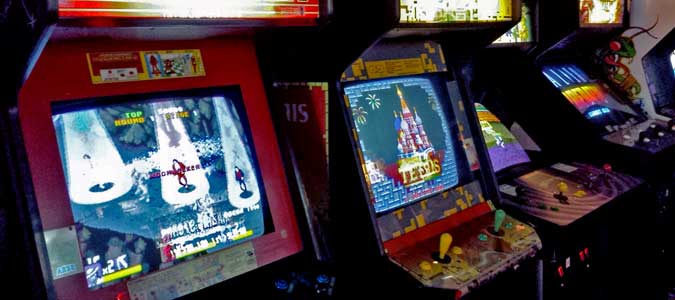This page may contain one or more affiliate links, which means that if you purchase a product through that link, I may receive compensation. The links will be identified with the text "affiliate link". Click to learn more.
During the 80s and 90s, when arcades were popular, video game arcades were the ultimate social hotspots, especially for young people looking to meet and connect with others. Man, those were the days. These vibrant amusement arcades were strategically located inside or near shopping malls, making them easily accessible and naturally drawing crowds. Think about it – where else could you find such an amazing mix of entertainment all in one place? The types of arcades back then had it all: air hockey tables where intense matches would unfold, pool tables for showing off your skills, classic arcade games with their hypnotic lights and sounds, birthday parties filled with excitement, hot pizza fresh from the oven, and ice-cold sodas to keep you going. The best part? All these awesome things in an arcade were meant to be shared with friends, creating the perfect recipe for social interaction and fun.
But here’s the thing – as technology evolved and home computers became more powerful, the magic of video game arcades started to fade. I mean, why would anyone want to leave their cozy home when they could just fire up Call of Duty online or play games on their smartphone? The convenience factor was just too strong to ignore. And let’s talk about the economics – when each of these coin-operated games costs fifty cents or a dollar for just a few minutes of play, who wants to empty their wallet at an arcade? The math just didn’t add up anymore, especially when you could buy a game once and play it unlimited times at home.
Unfortunately, this shift in gaming culture hit the arcade industry hard in the United States, reducing video game centers to a tiny niche market that barely hangs on today. But you know what’s interesting? The most valuable aspect of these legendary hangouts still resonates with people: the incredible social experience they provided. Think about how we meet people nowadays. At bars? Parties? It’s kind of awkward, right? You have to force yourself to approach strangers, make small talk, and pretend to be super interested in whatever they’re saying. But video game arcades? They made meeting people as natural as breathing. You’d spot someone playing one of the arcade games that caught your eye, drop a quarter in the machine, hit that magical PLAYER 2 START button, and boom – instant connection!
That’s the beauty of it – no complicated social dance required. Just press a button, and suddenly you’re gaming partners in these multi-player arcades. The rest would happen organically – you’d start helping each other out in the game, sharing strategies, laughing at mistakes, and having a blast together. Plus, the fact that you both chose the same game meant you already had something in common – an instant conversation starter. It was social networking before social networking was even a thing, and it worked beautifully.

Thankfully, some dedicated souls have kept the arcade spirit alive through arcade revival efforts. These modern-day heroes have created what we call “retro-arcades” – though they’re more like interactive museums of gaming history than traditional amusement arcades. These places operate differently from their predecessors, usually charging by time rather than per game. It’s a smart arcade game pricing model that lets people enjoy the arcade nostalgia without constantly feeding quarters into machines. While they might not replicate the exact social dynamics of the original arcades, they’re still keeping an important piece of gaming culture alive.
For some die-hard fans, the arcade experience is so precious that they’ve brought it right into their homes with home arcades. And you know what? It’s actually not as crazy expensive or complicated as you might think to own your own (affiliate link) gaming cabinet these days. Just imagine being able to share that classic 80s gaming experience with your kids – teaching them about the retro games you grew up with, showing them what gaming was like during the golden age of arcade video games, before high-definition graphics and motion controls. It’s a fantastic way to bridge the generational gap and create some amazing family memories while you’re at it.
The evolution of arcade game technology and arcade game innovation has been remarkable. From the early days of electro-mechanical games to the advanced graphics and immersive experiences of modern arcade games, the industry has come a long way. Today, we’re seeing a resurgence of interest in classic arcade games, with arcade bars and game bars popping up in cities across the country. These establishments combine the nostalgia of retro games with the social atmosphere of a bar, creating a unique entertainment experience for adults who grew up during the heyday of video game arcades.
As we look to the future, it’s clear that the spirit of the arcade lives on, albeit in different forms. Whether it’s through the preservation of classic arcade games in museums, the creation of new arcade-style experiences for home consoles, or the continued operation of amusement arcades in some parts of the world, the legacy of the video game arcade continues to influence and inspire gamers of all ages. The social-tainment aspect that made arcades so popular in their prime is still valued today, reminding us that sometimes, the best gaming experiences are the ones we share with others.

